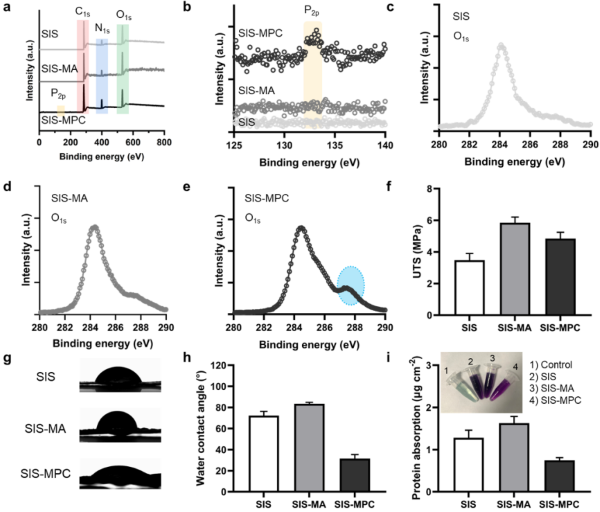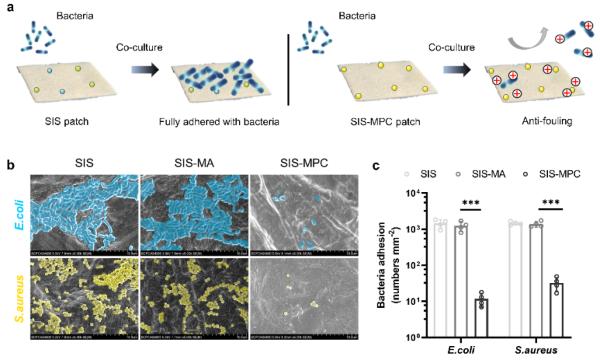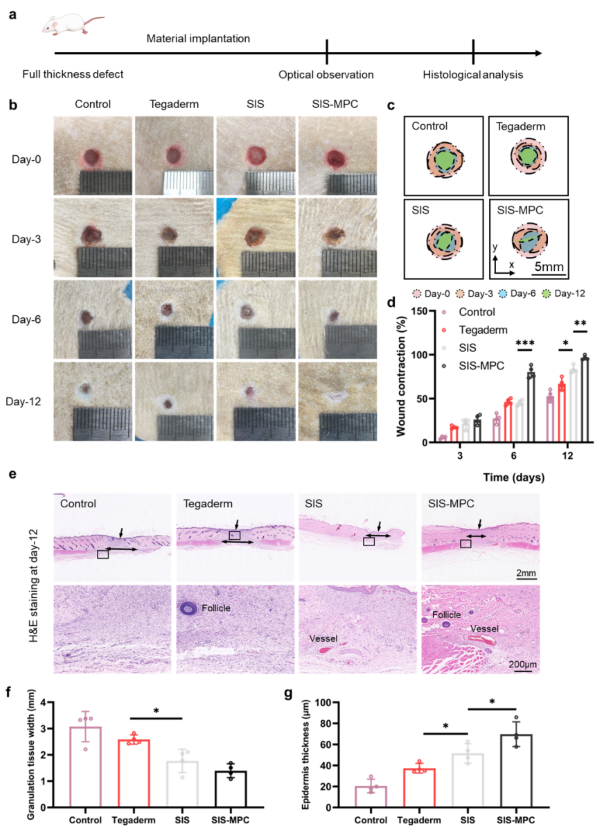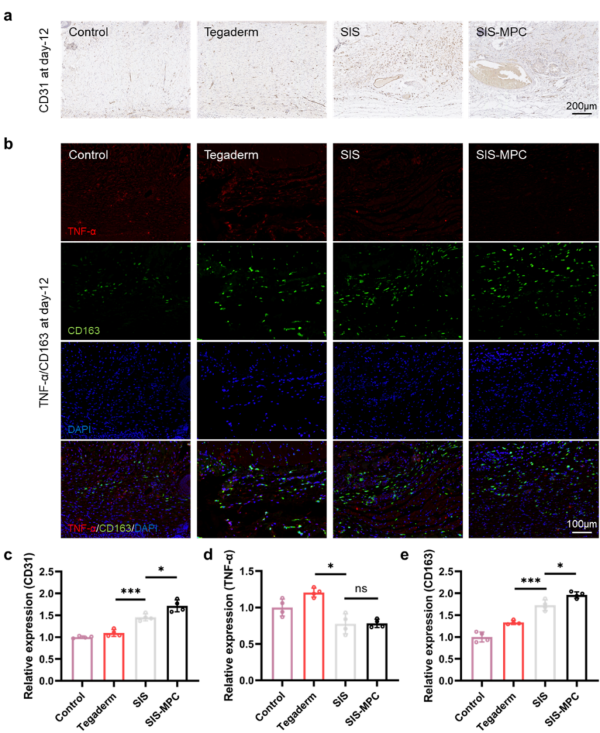Due to the increasing number of diabetic patients in the world and the lack of effective breakthrough treatments, the development of new therapy for diabetic chronic inflammatory wound injury has become an important research topic. The possibility of bacterial infection frequently occurs when the wound is exposed to external environments, The current wound dressing does not have antibacterial and anti-fouling performances. Therefore, it is necessary to develop a kind of materials with good biocompatibility and antifouling capacity for tissue regeneration of chronic diabetic wounds.
Based on this, Biosis Healing, together with the expert teams of Renmin University of China, the Second Hospital of Tianjin Medical University and Beijing Chao-Yang Hospital affiliated to Capital Medical University, prepared an SIS-based biological graft with anti-fouling and promoting vascularization by using SIS material with independent intellectual property rights. By introducing type of amphitropic molecules MPC, gives SIS graft excellent ability of anti-fouling and anti-bacterial adhesion. In the chronic wound model of diabetes, SIS-MPC has the hemostatic effect by rapidly recruit platelets and promote fibrin deposition, release endogenous biological activity factors to inhibit inflammation and accelerate vascularization, promote the wound repair and regeneration.
It is worth noting that this study confirmed for the first time that SIS materials promote wound healing through TGF-β and MAPK signaling pathways, which is prospective and pioneering, providing new evidence for SIS materials to promote tissue regeneration!

Recently, the latest research results "Decorated small intestinal submucosa (SIS) based bio-patch with anti-fouling and vascularized capacity to accelerate chronic wound regeneration in diabetes", was published by the first area top journal of Chinese Academy of Sciences "Applied Surface Science", with an impact factor of 7.392.
This research was completed by the team of Professor Zhao Bo, associate chief physician Yu Xueqiao, Dr. Wei Pengfei and Dr. Jing Wei from Biosis Healing, and the team of Professor Wang Yi from Renmin University of China, Dr. Ma Shiqing from Second Hospital of Tianjin Medical University, associate chief physician Ma Huachong from Beijing Chao-Yang Hospital affiliated to Capital Medical University.

Physical and chemical property of SIS-MPC bio-patch

Figure: Physicochemical performance of the materials. The results demonstrated that the SIS-MPC bio-patch owned good mechanical strength, hydrophilicity and anti-protein absorption for preventing tissue adhesion.

Figure: Anti-fouling performance of the materials.The above results demonstrated that SIS-MPC bio-patch has super anti - fouling ability.

Figure: Cytocompatibility of the materials. (a) Scheme for cytocompatibility evaluation, from isolating L929 fibroblasts and inoculating them on the SIS patches to for analysis. (b) Live/dead staining and cytoskeleton staining using calcein-AM/PI and Phalloidin/DAPI, when the cells had been seeded on the patches for one day. (c) L929 viability using CCK-8 reagent when the cells were grown on the patches for one day. (d) H&E staining to visualize the cells on the SIS patches.
Animal Experiment
The diabetic Sprague-Dawley (SD) rats with 5 mm full thickness skin defect was established in the animal experiment, and different treatments including using the SIS, SIS-MPC bio-patch, commercial wound dressing Tegaderm™, and control without covering implantation were carried out to evaluate the tissue regeneration and pathological analysis (Fig. a). Judging from the general wound tissue healing situation, the wound healing in the blank control was slow, and there were still obvious wounds 12 days after the operation (the healing rate was 52.95 ± 6.19 %). The wound repair effect of Tegaderm was slightly better than that of the blank control, but the wound was still more obvious at 12 days (the healing rate was 66.83 ± 6.67 %). Since the SIS material is rich in endogenous bioactive components such as VEGF, FGF, TGF-β, etc., the released active factors are conducive to vascularization, thereby accelerating wound repair, and the wound is significantly reduced 12 days after surgery (The healing rate was 83.35 ± 4.30 %). SIS-MPC had the best wound effect on the 12th day after surgery, with a healing rate of 96.63 ± 2.44 %, and there was almost no obvious wound (Fig. b-d). In the 12-day H&E staining, the SIS-MPC group showed obvious signs of angiogenesis and hair follicle formation, and the width of the granulation tissue was much lower than that of SIS, Tegaderm™ and other materials (Fig. e-g).

Figure. Evaluation of the various materials on full-thickness wound healing of diabetic rats. The above results indicate that SIS-MPC still has an excellent effect on promoting tissue repair for refractory wound injuries.
Study on wound healing mechanism
MPC in promoting wound repair compared with Tegaderm. We homogenized and lysed the 12-day tissue, performed RNA-seq gene sequencing, and found that 772 genes were specifically expressed in SIS-MPC, and 340 genes were significantly up-regulated by further analysis of the gene data. KEGG enrichment analysis showed that SIS-MPC mainly activates signaling pathways such as TGF-β, MAPK, and cell cycle. Among them, TGF-β stimulates cell proliferation and regulates the synthesis of extracellular matrix, and MAPK regulates the process of vascularization, therefore, SIS-MPC has favorable conditions to promote tissue repair.
We also detected VEGF and ECM receptor interaction signaling pathways, hemostasis and other signaling pathways in the SIS-MPC group, as well as obvious platelet and fibrin deposition in SIS-MPC, while on the Tegaderm™ surface, the platelet number is very limited, so the hemostatic ability of Tegaderm™ for tissue bleeding is limited in the early stage of wound appearance.
Based on the above results, we summarize the repair process of SIS-MPC in promoting wound healing of diabetic chronic inflammation: In the early stage of trauma, SIS-MPC recruits platelets and fibrin deposition, providing an initial stable physiological environment for healing; secondly, SIS-MPC has antifouling effect, resists exogenous microorganisms from invading wound tissue, releases endogenous active ingredients in SIS, reduces local inflammation expression, and finally, endogenous VEGF in SIS is released to accelerate vascularization and promote collagen production, so it is beneficial to wound healing. In addition, we took 12-day blood to test its hematological and biochemical examinations. After implanting the material, the blood indexes were all within the normal physiological range, which did not cause abnormality and had good histocompatibility. Therefore, SIS-MPC has excellent repair potential in the field of wound repair.

Figure: Investigation on the mechanism of the wound healing process

Figure: Genomics analysis on the effects of the SIS-MPC and Tegaderm™ in contribution to chronic wound repair in diabetic rats.
Author Introduction
Zhao Bo
Biosis Healing founder, doctor of surgery
Professor-level senior engineer/ associate chief physician/ graduate supervisor/ postdoctoral supervisor
As the main completion and project leader, he has undertaken and completed four projects of National Natural Science Foundation of China, Beijing Natural Science Foundation and many scientific research projects.
Wang Yi
Associate Professor, Master Director, Doctor of sports Medicine, Renmin University of China
Engaged in the empirical research of sports medicine for many years
Presided over 1 funding project of China manned space project, 1 National Social Science Fund and 1 project of General Administration of Sport of China
Research and development achievements have won China Patent Excellence Award for many times
Ma Huachong
Deputy chief physician of Beijing Chaoyang Hospital affiliated to Capital Medical University, graduated from the School of Clinical Oncology, Peking University, doctor of surgery
Member of Oncology Committee of Chinese Medical Doctor Association, young and middle-aged member of Colorectal Surgeons Committee, youth member of Gastric Cancer Committee of Chinese Anti-Cancer Association, youth member of Beijing Branch of Chinese Sociaty of Parenteral and Enternal Nutrition Committee
Participated in a number of research projects such as National Natural Science Foundation of China, IPO Fund, Wu Jieping Clinical Research Special Fund and President's Fund of Capital Medical University
Published more than 20 articles in authoritative journals at home and abroad, and participated in the compilation of 6 books
Ma Shiqing
Department of Stomatology, Second Hospital of Tianjin Medical University, Lecturer, Attending Doctor
Young committee of the Professional Committee of General Oral of the Chinese Stomatological Association
Research direction is guided tissue regeneration and implant surface modification
Presided over 1 youth project of the National Natural Science Foundation of China
In the past 5 years, published 5 SCI papers as the first author and 1 SCI paper as the corresponding author
Won the second prize of Tianjin Science and Technology Progress Award
131 Third-level Talents in Tianjin
Candidates for the "Young Reserve Talents Support Program" in Tianjin Universities
Outstanding Teacher of Tianjin Medical University
Yu Xueqiao
CMO of Biosis Healing, doctor of surgery, associate chief physician
Engaged in clinical work in gastrointestinal surgery for more than 10 years
Participated in and completed 3 projects of National Natural Science Foundation of China, presided over one Natural Science Foundation of Hubei Province and one scientific research project of Hubei Provincial Health Commission, and published more than 20 papers in professional journals at home and abroad as the first author or corresponding author
Jing Wei
Beijing Biosis Healing Biotechnology Co., Ltd. Post-doctoral
Doctor of Biomedical Materials, Beijing University of Chemical Technology
Supported by the 66th batch of China Postdoctoral Science Foundation
2020 Annual Postdoctoral International Exchange Program Academic Exchange Project
Wei Pengfei
Beijing Biosis Healing Biotechnology Co., Ltd. Post-doctoral
Doctor of Biomedical Materials, Beijing University of Chemical Technology
He was supported by the 68th batch of China Postdoctoral Science Foundation
2020 Annual Postdoctoral International Exchange Program Academic Exchange Project











版权所有®2019BIOSISHEALING